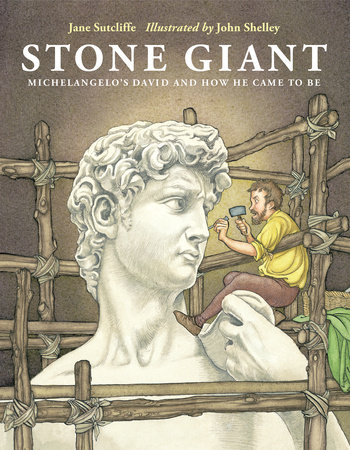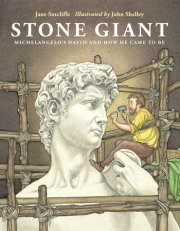Sutcliffe makes a big impression with this handsome introduction to one of Western civilization's most iconic sculptures.
When the young artist was summoned from Rome back to his native Florence, he was commissioned to take on a work of heroic proportions. This sculpture of the Old Testament hero David was to symbolize Florentine strength and civic virtue. Michelangelo requested "the giant"--an immense block of creamy marble that had been languishing for over 40 years. Sutcliffe limns the lively details of this multiyear project, and her tale of Michelangelo's talent and industry is considerably enhanced by the thoughtful pen, ink and watercolor work of British illustrator Shelley. He makes the finely modeled realism of the statue the real standout here. (Yes, there are a few views of David in full frontal splendor.) Shelley wondrously juxtaposes this cool, nuanced marble hero with a crowded city, brimming with the bright colors and lively action of Renaissance book illuminations. Backmatter includes an author's note and a brief bibliography (mostly adult titles, no online resources). Sadly missing? An artist's note to help curious readers place all the highly researched imagery and background in more complete artistic, historic and geographic context.
Still, this is a handsome offering that helps youngsters understand both an artist's process and how this stunning statue became the enduring symbol of a city and its people.
—Kirkus Reviews
Renaissance icon and one of the most towering (in more ways than one) of Western civilization’s artworks gets a humorous but respectful, down-to-earth, and easy-to-understand treatment. Readers learn that the city fathers always intended to have a statue of David carved, as a symbol of the small but powerful city, but that their plan wasn’t so simple. Many earlier attempts had come to naught, with even Leonardo da Vinci passing on the idea. Fortunately for Florence–-and posterity–-Michelangelo was persuaded to return from Rome and began his painstaking sculpting, bringing forth his giant almost three years later, in 1504. This well-written, lively account is graced with excellent illustrations, rendered in pen-and-ink and painted with watercolors, that truly convey a Renaissance Italian flavor; there’s even an image of Michelangelo’s sketches for the statue with a poem he wrote about it. Readers should note that David’s frontal nudity is discreetly concealed for the most part, but there is one scene in which the piece is shown from the front, completely uncovered, and another illustration depicts the statue’s bare backside. A helpful author’s note and bibliography conclude the book, though the note fails to reveal that David is now housed in the Accademia Gallery in Florence, and the bibliography includes mostly outdated resources and none that seem geared to young readers. Highly recommended for all public and school libraries and especially recommended for units on the Italian Renaissance and in art classes in the middle to upper-elementary grades.
—School Library Journal
It seemed like a great idea—a massive statue of Biblical giant-slayer David that would grace fifteenth-century central Florence and symbolize her power among surrounding contentious kingdoms. Unfortunately nobody, not even the redoubtable Leonardo, could pull off the project initially, until finally twenty-six-year-old Michelangelo Buonarroti took on the challenge. Sutcliffe presents a streamlined but lively description of the artist's work process, from building a workroom around the enormous slab of abandoned and eroding marble, to Michelangelo's renowned method of chipping away all the "not-David" material until the figure emerged, to the onerous task of hauling and installing the creation in its presumably permanent location. At this point, knowledgeable prospective book purchasers are asking the obvious question: "So, just how much David is on view?" Well, ultimately, all of him. However, Shelley manages to keep the statue under wraps via strategically placed models and scaffolding until the glorious full-frontal reveal, thus also helping to keep the picture-book audience attentive and under control until they share with the Florentines themselves an inevitable gasp of amazement. Figures of Michelangelo and the Florentine citizens are touched with humor, while in contrast the statue retains its gravitas. Text boxes are encased in embellished framing and the city unfolds in the foreshortened perspective of medieval painting. An author's note provides extra information about subsequent alterations to the statue and its eventual removal indoors; a bibliography of adult resources is also included. Every veteran librarian knows what happens when a child with a marker meets a book with a naked guy, so perhaps it's wise to purchase an extra backup copy.
—The Bulletin of the Center for Children's Books







